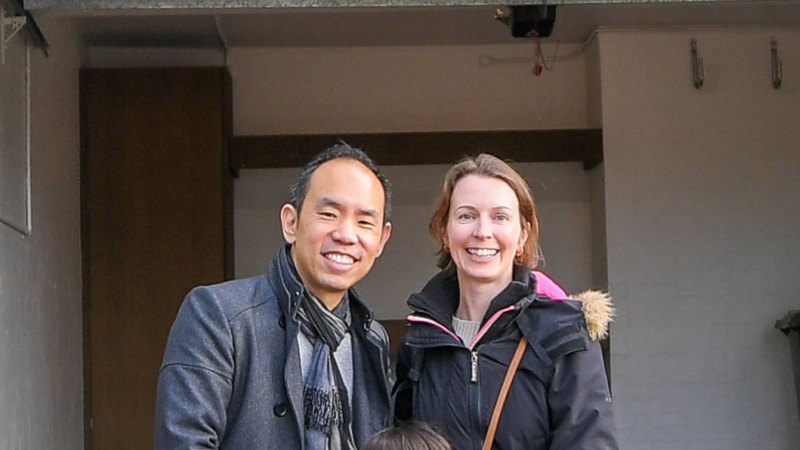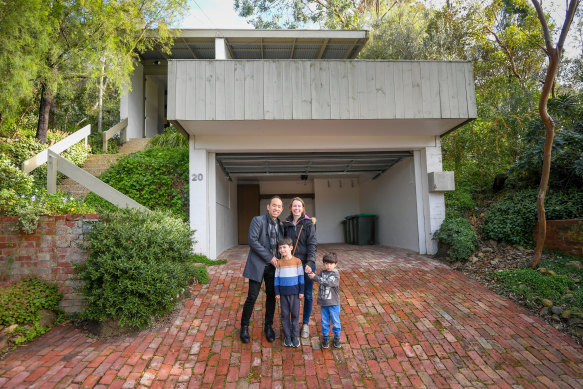
What’s in a name? Boosting the value of your postwar home
September 12, 2023Save articles for later
Add articles to your saved list and come back to them any time.
When it comes to selling postwar architecture (built after 1945), the name of the architect can push up the price. Take the example of a house in East Ringwood designed by architect Robin Boyd, which sold in July for $1.61 million by Jellis Craig Bundoora for about $240,000 over the reserve.
Designed in the late 1960s, it, along with other postwar architect-designed homes, was on the “bucket list” of architect Craig Tan. Tan purchased the four-bedroom, multi-level house among stiff competition.
Auction winner Craig Tan with his family wife Gemma and children Ruben and Harrison and their Robin Boyd house in East Ringwood.Credit: Justin McManus
“I was looking in quite a broad range of areas, including suburbs such as Rosanna where I missed out on a Merchant Builder’s house designed by architect Charles Duncan,” says Tan, who loves the way many of these postwar architects connected to nature.
“There’s a sense of materiality that comes with this period, whether it’s the exposed brick walls or the chunky timber beams,” he says.
While the name Robin Boyd holds cache with many architects, it’s also attractive to others who appreciate what this period offers.
“The Boyd house embraces the views of the Dandenong Ranges as much as the naturalist-style garden,” says Tan, who knew that the original estimate of between $900,000 and $990,000 given by the agents would probably not give him the keys to this property.
Shannon Whitney, founder and director of BresicWhitney, cites two eminent postwar architects – Harry Seidler and Neville Gruzman – as attracting interest when their houses come onto the Sydney market.
“Areas such as Castlecrag and Bellevue Hill are worth looking at when it comes to great postwar architecture. You will also see the work of others such as Peter Muller,” says Whitney, who considers the market for architect-designed houses from the 1970s to be gaining momentum.
Whitney has sold several Gruzman homes in Sydney’s eastern suburbs.
“You certainly wouldn’t say they get premium prices for this part of Sydney, but his name certainly comes with cache,” says Whitney, who sees a greater awareness for this type of property. One house in Bellevue Hill, designed in the early 1970s, is attracting interest from buyers.
“These houses come with great natural light and well-conceived floor plans. They’re no longer seen as the ‘ugly ducklings’,” says Whitney, who contributes part of this appeal to the public’s exposure through television and via magazines.
While these virtually intact period homes appeal to the purists and many design buffs, according to Whitney, “those that have been thoughtfully updated for contemporary living have broader appeal and receive greater prices”.
A similar sentiment for postwar architect designed houses is shared by Andrew Sahhar, director at Kay & Burton.
“People are certainly attracted to houses that have that LA sensibility, with their generous glazing and high ceilings. It also helps if the architect behind these designs is either Neil Clerehan, Guilford Bell or Holgar & Holgar,” says Sahhar, who sees young families particularly drawn to this period of architecture.
“You could say these homes are back on trend,” he says.
For architect Craig Tan, who is now the proud owner of the Robin Boyd house – the last to be designed by Boyd – it’s the history as much as the design that captivates him.
“I was speaking to Karl Fender (director of Fender Katsalidis) before I bought the house. He worked for Boyd as a young graduate, measuring up the levels in the garden,” says Tan.
“The house was also designed for Patrick Hegarty, a journalist who formed a close association with Boyd. It’s that knowledge that lingers rather than the price I paid.”
Expert tips on how to save, invest and make the most of your money delivered to your inbox every Sunday. Sign up here for our Real Money newsletter.
Most Viewed in Money
From our partners
Source: Read Full Article



